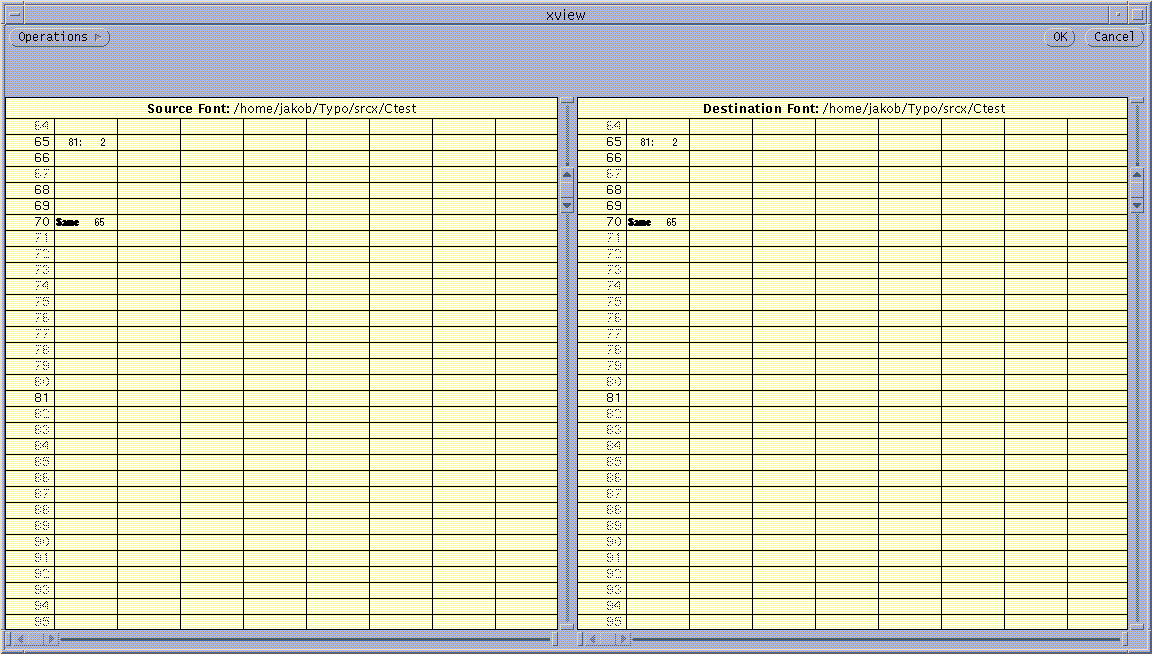Sometimes specific character pairs produce optically bad spacing.
For example, the letter pair 'VA' will produce too much white space
in between.
The following figure shows these characters set using standard widths
and using corrected widths. Before electronic typesetting, this effect was
achieved by cutting off part of the lead on both character bodies until the
proper character distance was achieved; therefore the term kerning.
An unkerned and a kerned word |
TYPO supports character pair kerning by specifying width adjustments
for character pairs within a font.
Two different operations are provided.
Kerning defines a width adjustment (kerning value)
whenever the current character is followed by another specific character.
The user is first asked to input the character position or name of
the following character.
A dashed line is displayed which indicates the default position of
the following character (zero kerning), and a solid line shows its
kerned position.
The user determines the kerning value by
positioning the following character.
Usage of the Typeset facility is recommended
while establishing the kerning value for a character pair.
Note that these kerning values belong to the current character and
are only added to a font when the character is saved.
The kerning values defined for a particular font can be viewed and updated
with the File->Font Edit->Kern command.
This commands pop up the kerning window.
Moreover, a source font can be specified, from which kerning
information can be copied into the current font.
If no source font has been specified, the destination font acts also as the
source font.
An example kerning window is shown in the following figure.
The Kerning Window |
Each character is shown with its following characters and the corresponding
kerning values;
each such character/value entry is called a kerning item.
Empty font positions are shown in grey.
The scroll bar at the right of the window can be used to
scroll to other characters in the font; the scroll bar at the bottom
can be used if a character has more kerning pairs than fit in a screen.
By pressing the right mouse button, a menu pops up and a command can be
chosen from that menu.
The Edit->Again key is also applicable in the kerning window;
it repeats the last Operations command.
Several of the following commands involve a source and a
destination selection.
A selection can either be the whole font (the font name is selected),
a single character (the character position is selected),
or a single kerning pair (that pair is selected).
If the the source selection is a kerning item, or sequence of such,
all these kerning items are copied to the character selected as the
destination.
If the the source selection is a character, or sequence of such,
the kerning items of all these characters are copied to the
corresponding characters in the destination font (note that any
destination selection is ignored).
If the the source selection is the whole source font,
all the kerning information from the source font
is copied to the destination font.
The user is prompted to confirm if any kerning information is overwritten.
The value in the kerning item selected in the destination font
can be modified with the Change Item command.
The user is prompted for the kerning value
(terminated by RETURN or LINE FEED).
A new kerning item is added to the
character selected as the destination character
with the Add Item command.
The following character is specified by the source selection.
The user is prompted for the kerning
value (terminated by RETURN or LINE FEED).
It is sometimes required that two characters kern alike with their
following characters.
One way to handle this is to copy the kerning information from one character
to the other. This strategy has the disadvantage that kerning
changes in one character are not reflected in the other.
The Kern Same as command makes the destination selection character
kern like the model character, selected as the source,
by establishing the SAME AS relationship.
All future kerning changes made to the model character are automatically
reflected to all the characters which are SAME AS the model character.
A SAME AS relationship can be deleted with the Unkern
commands described below.
Note that nested SAME AS relationships
(A SAME AS B, B SAME AS C) are not valid
(even though no validity check is made by TYPO).
If the destination selection is a kerning item, that item is deleted.
If the destination selection is a character,
all kerning information in that character is discarded.
If the destination selection is a whole font,
then the whole destination font gets unkerned.
To prevent inadvertent unkerning, the user is prompted to
confirm this operation.
Displayable characters are either shown by their ordinals or by their
ASCII character representation; the Ordinals/ASCII command flips between
these two display modes.
The kerning window can be left with the Exit Kerning command
or by pressing the OK button.
Pressing Cancel will ignore all the changes made during this
File->Font Edit->Kern command.


